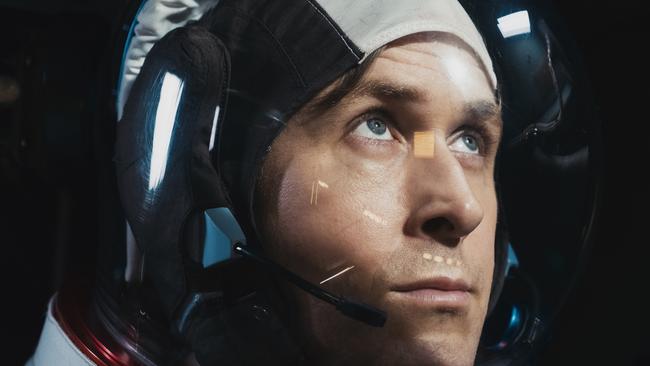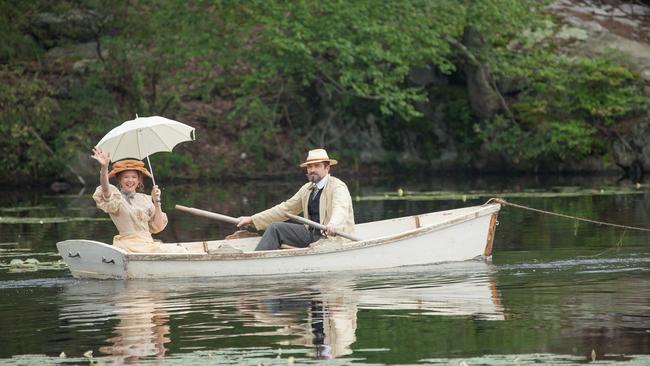First Man, The Seagull, Harmony: film reviews
Examining Neil Armstrong’s small and challenging steps as he prepares to make mankind’s giant leap.

Next July we will mark the 50th anniversary of the first manned moon landing, when Neil Armstrong took that “one small step for man, one giant leap for mankind”. The story of the US space program has been told before on film in Philip Kaufman’s impressive The Right Stuff (1983), and now in First Man, his first movie since La La Land, director Damien Chazelle tells it again, very specifically from Armstrong’s perspective. The emotionally stitched-up Armstrong is portrayed by Ryan Gosling as a man who is so stoic and so determined to get the job done that he becomes alienated even from Janet (Claire Foy), the wife he adores.
One of the film’s great achievements is that it gives the viewer a real sense of what space travel was like in those pioneering days. It’s far from glamorous, that’s for sure. The space capsules in which the astronauts travel are cramped, claustrophobic and uncomfortable. One of the great achievements of Chazelle and his technical team is the seemingly authentic representation of this hellish experience; the use of sound is brilliant — the use of silence too — as the little spacecraft judders and shakes so fiercely that it seems as if it will fall apart.
Unfortunately, Swedish cinematographer Linus Sandgren hasn’t confined his photography of scenes in which the characters are jolted and jerked to the space sequences but carries the style over into the domestic scenes, to distracting effect. That’s one of the film’s disappointments.
First Man opens with a scene set in 1961 when Armstrong, a test pilot with engineering experience, flies an X-15 so high up into the clouds that he almost doesn’t make it back. This is our introduction to an unflappable, intense and introverted pioneer who never really recovers from the death, from cancer, of his beloved daughter before she reached the age of three.
The race to put a man on the moon before the Russians was a significant component of the Cold War, and many Americans were inspired by John F. Kennedy’s great speech, delivered before congress in 1961, in which he vowed to do just that. Armstrong is accepted into NASA’s astronaut program, and he and Janet move into accommodation in the suburbs of Houston where their neighbours are other astronauts; they become best friends with Ed White (Australia’s Jason Clarke) and his wife, Pam (Olivia Hamilton).
Chazelle and screenwriter Josh Singer, working from James R. Hansen’s 2005 biography of Armstrong, play down the jingoistic elements that could have marred the film. This presumably is why they don’t show the planting of the US flag on the moon, an omission that, not surprisingly, has been attacked by some commentators.
Of course we all know the story, and those who are old enough will remember where they were on that day in July 1969. (I was attending the Moscow Film Festival, where members of the US delegation were trying to control their excitement and enthusiasm.) But probably not many of us were aware, in a way that this flawed but generally impressive film makes us aware, just how “a bunch of guys making models”, as Janet describes them, changed the course of history. Chazelle also reminds us that not all Americans were happy about the billions of dollars being spent on space exploration: there’s a terrific scene in which the song Whitey on the Moon reminds us that for many African-Americans living in poverty, space travel was nothing to get excited about.
Then there are the ever-present dangers. While Armstrong is reluctantly in Washington, assigned to charm congressmen into continuing funding support of NASA, his friend Ed and two other astronauts are killed when a wiring fault ignites a fire in the capsule on the launch pad.
Despite this ambitious film’s shortcomings — which, apart from the camerawork in the domestic scenes, include a protracted running time — it delivers the goods in its hugely impressive depiction of what pioneering space travel was actually like. The performances by Gosling — in a difficult, interior role — and Foy are exemplary, especially in a key scene in which, on the eve of the attempt to reach the moon, Janet compels a reluctant, taciturn Armstrong to sit down with his sons and tell them just how dangerous the mission is. It’s a film with its share of memorable scenes, and this is a moment you’re unlikely to forget.
The last time an American director attempted to film Anton Chekhov’s 1896 play, The Seagull, was in 1968 when director Sidney Lumet assembled a fine cast — Simone Signoret, James Mason, Vanessa Redgrave and David Warner among them — for what turned out to be a disappointing adaptation. The new version, by director Michael Meyer, is far more successful in catching the elusive atmosphere of the Russian master’s work.
With a screenplay by Stephen Karam, the film opens in Moscow in 1904, when the ageing actress Irina Arkadina (a superb Annette Bening) learns that her brother Sorin (Brian Dennehy) is dying in the family’s country house. Once there, Irina — who is always “performing”, even for members of her own family — is reunited with her son Konstantin (Billy Howle). Then the film winds back two years to tell the story of Konstantin’s love for Nina (Saoirse Ronan), a young actress, and Irina’s troubled relationship with Boris Trigorin (Corey Stoll).

As a story about missed opportunities and betrayals, The Seagull is timeless. Ingmar Bergman’s Smiles of a Summer Night (1955) was influenced by it, and with the right cast and the right touch Chekhov’s delicate plotting comes dazzlingly to life. This is a pared-down version notable for Meyer’s use of probing close-ups. Karam has pruned some of the original’s speeches, which may annoy purists, but the result is a higher level of naturalism. The cast is wonderful and Bening, in particular, has never been better.
Harmony — The Five Frequencies Saga, Part 1 (to give the film its complete on-screen title) is a low-wattage Australian fantasy film from writer and director Corey Pearson. It was filmed on locations in Sydney and Wollongong, but it’s set in an unnamed American city and it’s one of those irritating local films in which all the Australian actors adopt American accents.
There are, we are told, five Frequencies in the Universe, and the film, presumably designed as the first of a series, explores one of them: Harmony, or the balancing of Love and Fear.
The central character, who can extract fear from other people at some cost to herself, is Harmony, played by the darkly attractive Jessica Falkholt, who died tragically with her family soon after the film was completed. She is perfectly fine in this well-photographed and adequately directed movie but, like everyone else involved, she could have benefited from a stronger and more interesting screenplay.
First Man (M)
3.5 stars
National release from Thursday
The Seagull (M)
3.5 stars
National release
Harmony (M)
2 stars
Limited release

To join the conversation, please log in. Don't have an account? Register
Join the conversation, you are commenting as Logout